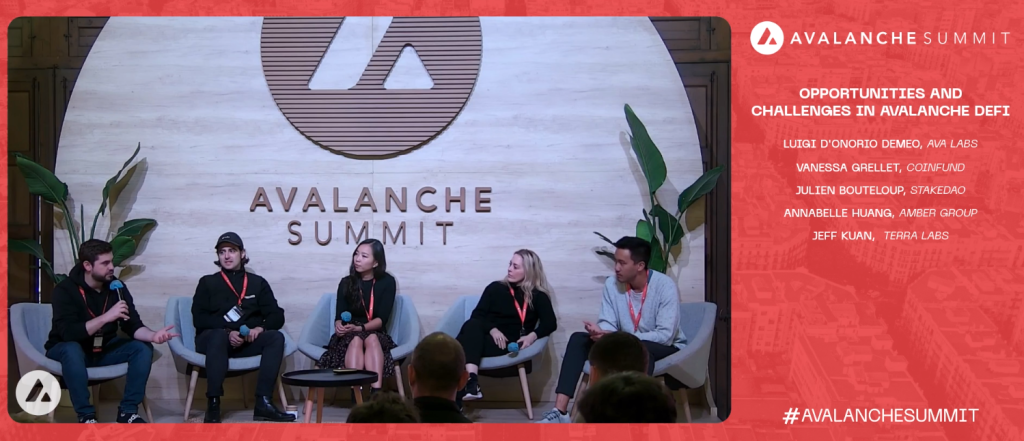Luigi D’onorio from Ava Labs (Host), Julien Bouteloup from StakeDao, Annabelle Huang from Amber Group, Vanessa Grellet from Coinfund and Jeff Kuan from Terra Labs spoke on the opportunities and challenges of DeFi on Avalanche.

How to see growth in DeFi?
1. Product Innovation
As the DeFi matures, the introduction of more complicated products such as derivatives, options, and futures has slowed innovation in the space. Yet it has not reach its full stride as the DeFi space has yet to mirror real-world assets and trade them in real time. This is only expected to take another two to three years to reach that point.
2. Growing the pie
Adoption has also slowed down mainly due to the fact majority of DeFi currently appeals to crypto natives rather than the average daily consumers to utilize. Also, due to specific regulations, traditional financial clients may not be able to directly utilize certain DeFi features at this time.
- A friendly façade: Increasing the size of the pie by creating applications that targets real work people without making it obvious they’re interacting with blockchain products on the backend.
- Gaming: There is a huge overlap with gamers and those interested in crypto, gaming could be the element which see the next million users onboard crypto.
- Insurance and risk management tools: Applications that can be used to manage risk of liquidations could potentially see mainstream adoption from institutions.
- Stablecoins as the appetizer: Regulated stablecoins are one alternatives for smaller business or traditional institutions to come into crypto for the yield pickup as they may not be comfortable with the exposure of volatility with Bitcoin and Ethereum just yet.
Multi-chain exists, time for the inter-chain
Think of blockchains like countries, where use cases are specific to different blockchains. Countries may compete on a global level, maybe based on their GDP (this could be marketcap in crypto), but through globalization and trade, majority of them became better off.
Users would go to blockchains that support their use cases the best but there arise the next issue. The steep learning curve.
For inter-chain to exist, the key metrics in measuring its success is the ability to mask web 2 experience onto the web3 infrastructure. The moment where users can not tell the difference between the 2, not only will the interchain narrative take off but the entire crypto space should buckle up.
Is UX on DeFi bad?
It is hard to imagine just five years ago DeFi was incomprehensible for a normal person — this might be due to the fact that developers were developing products for developers in order for them to build on protocols.
Devs understand devs, but now DeFi is catered to the masses and the interface has to revolve around these new bunch of end users.
UX simplifies but could also be a limiting factor in bringing out the full potential of what DeFi holds. Lets take a wallet for example, the first thing that comes to mind is it simply holds your cash and your payment cards.
Now if you think the same about wallets you know in DeFi, you are only scratching the surface. They are so much more functionalities that comes with it, it could be an art gallery to your access to the metaverse.
Perhaps we have to remove any presumptions in what we already know and until them, we can embrace the fullness of DeFi.
I’d say portion of the growth in crypto from 5 years ago till present day can be attributed to DeFi. This advancement is only the start, I cant wait to see what else is installed in the future.
[Editor’s Note: This article does not represent financial advice. Please do your own research before investing.]
Featured Image Credit: Chain Debrief
Also Read: Avalanche Summit: What Blocks People from Entering DeFi? An Introduction to OnDefy



































